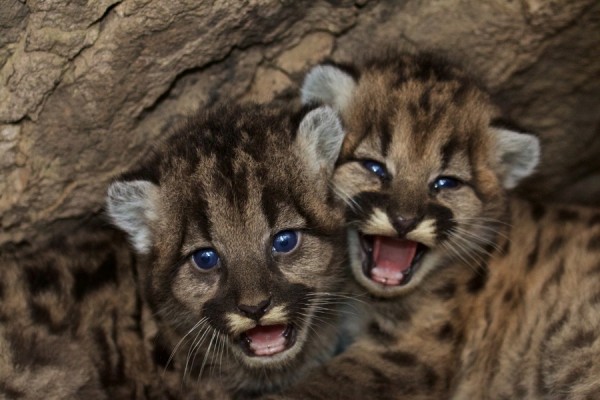By Ana Verayo, | January 18, 2016

P-46 (female) and P-47 (male) are the newest members of the National Park Service mountain lion study.
Biologists recently discovered two mountain lion kittens deep in Santa Monica mountains, just west of Los Angeles, according to the National Park Service.
According to biologist Jeff Sikich from the Santa Monica Mountains National Recreation Area, these newborns suggest that the quality of mountain cats' habitats are high for a relatively suburban region.
Like Us on Facebook
Sikich also says that this is a favorable response from successful reproduction that is indicating that the natural habitat's quality is high for an urbanized area. However, these kittens still face many challenges in the future, such as steering clear of other mountain lions, crossing freeways and even dealing with rat poison exposure.
On Thursday, the park service says that Sikich is suspecting that the mother of these cubs is a mountain lion known as P-19, where it may have given birth in a specific area where GPS data have shown that the lion stayed there for three weeks. Researchers and scientists have been monitoring P-19 since 2010, when it was just about a few weeks old.
The den of the mother mountain lion was located in a remote area near the western edge of the range. Biologists then implanted tracking devices to the female and male kittens that are now known as P-46 and P-47, as scientists will now conduct a DNA test in order to identify their father.
According to officials of the Santa Monica Mountains National Recreation Area, the main goal of marking these kittens is to learn more about their habitat, in part of a decade long study to also better understand how urbanization is affecting a vulnerable mountain lion population.
Researchers say that following them from such a young age can offer a unique chance to understand the challenges of these mountain lions where new insights from this study can now be applied, leading to a significant impact in conservation efforts.
Since 2002, these kittens are the ninth litter to be marked from a den site where two others are also marked some months before their births.
Biologists reveal that P-19's two previous litters were a result of inbreeding which can be dangerous to the survival of the species within the area. Since March 2015, P-12 has not been observed where it is possible that the new male line is P-45.
The park also proposed a wildlife crossing over the 101 Freeway connecting to the Santa Monica mountains to the Sierra Madres, so that it can expand their habitat, preventing inbreeding in the process.
-
Use of Coronavirus Pandemic Drones Raises Privacy Concerns: Drones Spread Fear, Local Officials Say

-
Coronavirus Hampers The Delivery Of Lockheed Martin F-35 Stealth Fighters For 2020

-
Instagram Speeds Up Plans to Add Account Memorialization Feature Due to COVID-19 Deaths

-
NASA: Perseverance Plans to Bring 'Mars Rock' to Earth in 2031

-
600 Dead And 3,000 In The Hospital as Iranians Believed Drinking High-Concentrations of Alcohol Can Cure The Coronavirus

-
600 Dead And 3,000 In The Hospital as Iranians Believed Drinking High-Concentrations of Alcohol Can Cure The Coronavirus

-
COVID-19: Doctors, Nurses Use Virtual Reality to Learn New Skills in Treating Coronavirus Patients







